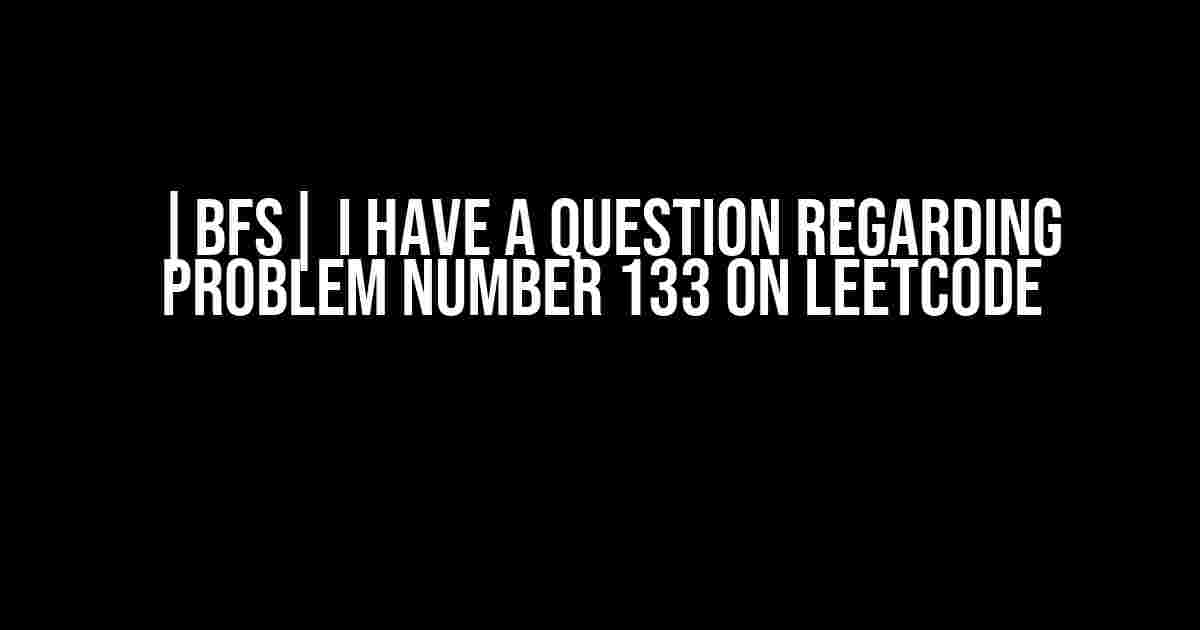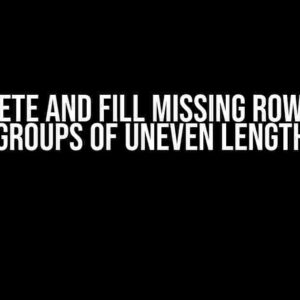Welcome, fellow programmers! Today, we’re going to tackle a fascinating problem on LeetCode – Clone Graph, also known as problem number 133. If you’re struggling to understand the concept of Breadth-First Search (BFS) or need a refresher, you’re in the right place! In this article, we’ll delve into the world of graph traversal, explore the problem statement, and provide a step-by-step solution using BFS.
Problem Statement: Clone Graph (133)
The problem statement is as follows:
Given a reference of a node in a connected undirected graph, return a deep copy (clone) of the graph. Each node in the graph contains a val (int) and a list (List[Node]) of its neighbors.
class Node {
val: int
neighbors: List[Node]
}
For example, given the following graph:
| Node 1 | Val: 1 | Neighbors: [Node 2, Node 4] |
| Node 2 | Val: 2 | Neighbors: [Node 1, Node 3] |
| Node 3 | Val: 3 | Neighbors: [Node 2, Node 4] |
| Node 4 | Val: 4 | Neighbors: [Node 1, Node 3] |
Your task is to write a function that returns a deep copy of this graph.
Understanding Breadth-First Search (BFS)
BFS is a graph traversal algorithm used to explore nodes in a graph level by level, starting from a given node. It’s a crucial concept in computer science, and understanding it is essential for solving problems like Clone Graph.
Here’s a brief overview of how BFS works:
- Create a queue and add the starting node to it.
- While the queue is not empty, dequeue a node and visit it.
- Enqueue all unvisited neighbors of the dequeued node.
- Repeat steps 2-3 until the queue is empty.
Solution Using BFS
Now that we’ve refreshed our knowledge of BFS, let’s dive into the solution for Clone Graph.
We’ll use a hash map to keep track of visited nodes and their clones. Here’s the step-by-step solution:
def cloneGraph(node):
if not node:
return None
visited = {} # Hash map to store visited nodes and their clones
queue = collections.deque([node]) # Initialize the queue with the given node
while queue:
node = queue.popleft() # Dequeue a node
if node not in visited: # If the node hasn't been visited
clone = Node(node.val) # Create a clone of the node
visited[node] = clone # Add the node and its clone to the hash map
for neighbor in node.neighbors: # Enqueue all unvisited neighbors
if neighbor not in visited:
queue.append(neighbor)
# Connect the clones based on the original graph structure
for node, clone in visited.items():
for neighbor in node.neighbors:
clone.neighbors.append(visited[neighbor])
return visited[node] # Return the clone of the original node
Let’s break down the solution:
- We create a hash map `visited` to store visited nodes and their clones.
- We initialize a queue with the given node and start the BFS traversal.
- In each iteration, we dequeue a node and create a clone of it if it hasn’t been visited before.
- We add the node and its clone to the hash map and enqueue all unvisited neighbors.
- After the BFS traversal, we connect the clones based on the original graph structure using the hash map.
- Finally, we return the clone of the original node.
Time and Space Complexity
The time complexity of this solution is O(N + M), where N is the number of nodes and M is the number of edges. This is because we visit each node and edge once during the BFS traversal.
The space complexity is O(N), as we store all nodes in the hash map.
Conclusion
In this article, we’ve conquered problem number 133 on LeetCode – Clone Graph – using Breadth-First Search (BFS). We’ve not only refreshed our knowledge of BFS but also applied it to solve a real-world problem. By following the step-by-step instructions and explanations, you should now be able to tackle this problem with confidence.
Remember, practice is key to mastering algorithms and data structures. Keep practicing, and soon you’ll be a master of LeetCode and beyond!
Happy coding, and don’t hesitate to reach out if you have any questions or need further clarification!
Frequently Asked Question
Got stuck on LeetCode’s problem number 133? Don’t worry, we’ve got you covered! Here are some FAQs to help you navigate through the challenges of implementing Breadth-First Search (BFS) in problem number 133.
What is the main idea behind problem number 133 on LeetCode?
The main idea is to clone a graph using Breadth-First Search (BFS) algorithm. You need to traverse the graph level by level and clone each node and its connections.
How do I keep track of visited nodes in the graph?
You can use a hash map to store the visited nodes. The key can be the node’s value or index, and the value can be the cloned node. This way, you can quickly check if a node has been visited before.
What is the time complexity of the BFS solution?
The time complexity is O(N+M), where N is the number of nodes and M is the number of edges. This is because we visit each node and edge once during the BFS traversal.
How do I handle the edge cases, such as the graph being empty or having only one node?
You can add simple checks at the beginning of your solution to handle these edge cases. For example, if the graph is empty, return an empty graph. If the graph has only one node, return a graph with a single node.
What is the most common mistake people make when implementing the BFS solution?
One common mistake is not correctly handling the connections between nodes. Make sure to clone each node’s neighbors and connections correctly to avoid infinite loops or missing edges.


